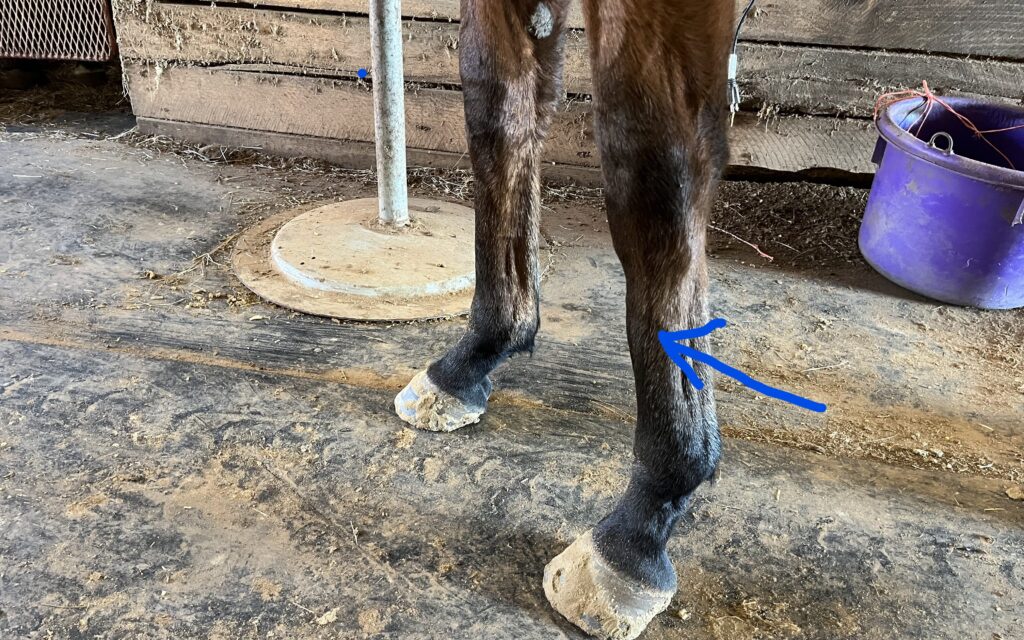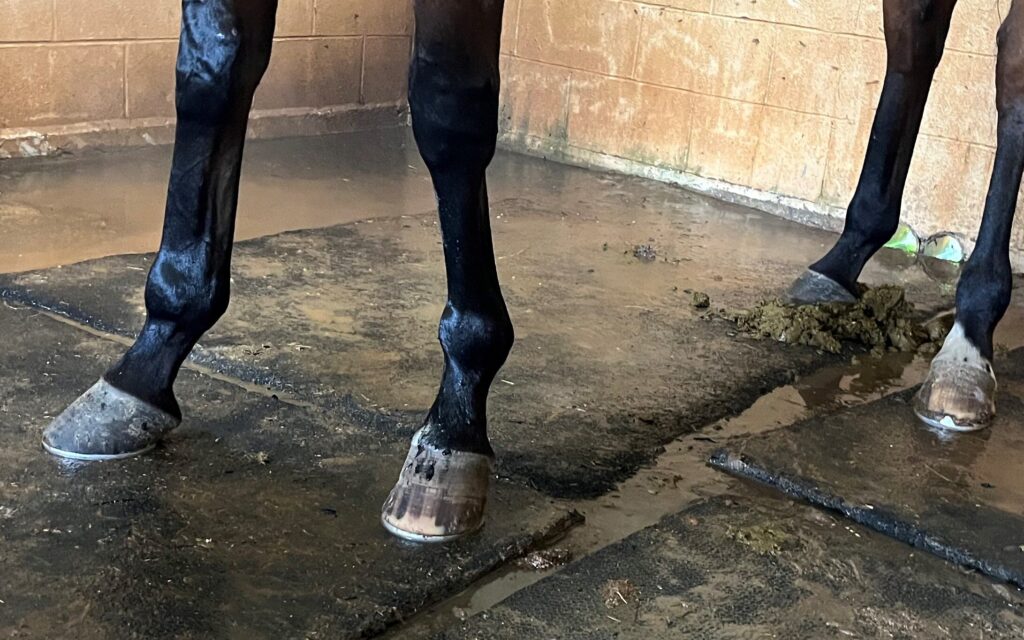Last updated: April 15, 2023
Any links on this page that lead to products on Amazon are affiliate links and I earn a commission if you make a purchase. Thanks in advance – I really appreciate it!
A typical day of watching horses at the training center took an unexpected turn when one trotted by with a noticeable limp. Upon closer inspection, her leg was warm and swollen, clearly in need of attention. Thankfully, the trainer contacted a vet immediately for evaluation and treatment – he prescribed rest and gave her some DMSO.
Dimethylsulfoxide (DMSO) is used to treat various injuries and inflammations in horses. DMSO can be administered topically, orally, or intravenously. Although DMSO is generally safe, some risks are associated with its intravenous use. If administered too quickly or if the concentration is too high, it can cause muscle tremors, diarrhea, colic, or other adverse reactions.
If you own horses or spend a lot of time around them, having a good grasp of the uses of DMSO is essential. So let’s find out more about versatile medication and see whether your horse can benefit from it.

What Is DMSO?
DMSO is a chemical compound that was first discovered in the late 1800s as a byproduct of the kraft process, which is used to make paper from wood pulp. In a groundbreaking discovery in the 1960s, scientists uncovered that DMSO could transport drugs through the skin without causing any damage.
This revelation opened up new possibilities for providing medication treatments to the body that didn’t require users to rely on needles or pills. Since then, it has been used for a variety of industrial and medical applications.
Recently, Gerald Krystal and researchers from the University of British Columbia investigated DMSO as a potential treatment for autoimmune conditions such as rheumatoid arthritis. In early studies, DMSO has shown promise in reducing joint pain and swelling.
It is also being looked at as a potential treatment for cancer, as it has been shown to inhibit the growth of cells. However, more research is needed to confirm the safety and efficacy of DMSO before it can be widely used as a medical treatment. You can read more about the research here.
DMSO is widely used today to deliver medications topically, such as through patches and gels. It has become especially beneficial for the treatment of pain and inflammation in humans and animals.
However, some veterinarians argue that using DMSO to treat fresh leg injuries can do more harm than good, as emergency care involves icing a horse’s legs. You should not use it on open wounds.

What Ailments Is DMSO Used To Treat In Horses?
Horse owners and veterinarians have been using DMSO to treat different ailments in horses for many years. As a topical solution, it’s commonly used to treat muscle soreness, inflammatory conditions, and pain. Bowed tendons, for example.
DSMO, given orally and intravenously, is used by veterinarians to treat horses with laminitis, arthritis, and neurological conditions, such as EPM. There was an investigation into the effectiveness of using DMSO in multiple ways.
Researchers conducted a study of two groups of horses with arthritis. One group injected DMSO in the horse’s joints and rubbed DMSO on their legs. In the second group, they only injected the horse’s joints. After a course of treatment, the researchers noted a marked improvement in the first group over the second.
Below is a helpful YouTube video that shows one way to use DMSO on your horse’s legs.
How To Use DMSO To Treat Common Issues In Horses (Dosage)?
Not many studies show how to determine the right dose of DMSO, and it’s sold in many different concentrations. I just checked on Amazon, and they have it available from 10% to 99.99% pharmaceutical grade.
Trainers advise using it once a day, twice a day, and even more often. But no one really knows what dose works best. It’s the same for taking it orally or through an IV. The dose is based on what the veterinarian thinks is best; however, they typically use 1g/kg of body weight.
Here’s how we use DMSO on our horses with swelling in their legs. Initially, we ice our horse’s legs; next, we wash the area thoroughly and apply a 40% gel concentration once a day for five days. This is stinky and messy so wear rubber gloves when applying.

The Benefits Of Using DMSO For Horse Health
DMSO can have several benefits for horses, even apart from pain relief. Here are some of the advantages of using DMSO.
- Reduce Inflammation
DMSO binds free radicals in the horse’s system, which can damage healthy cells. During an injury, the inflamed area can produce many free radicals, increasing swelling and producing more radicals. This is just the body’s way of trying to heal itself.
DMSO can reduce these radicals in the body and prevent the damage caused by inflammation to healthy tissue and help it heal faster.
A surgical vet suggested rubbing down our lame horse with DMSO after its surgery. We used the compound for three months post-surgery, and it kept the swelling down and promoted a quick recovery.
- Prevents Microbial Growth
DMSO can help prevent bacteria and microbes from reproducing. It is a bacteriostatic agent and can help prevent infections at the injury site.
It, however, doesn’t kill bacteria. It only prevents its growth, which can be helpful in itself. So it can help to clean guttural pouches, wounds, or abscesses.
- Draws Fluid
DMSO can also help with edema in horses. Acute pulmonary edema occurs when a horse’s lungs are filled with a lot of fluid, which makes it hard for the horse to breathe properly.
With DMSO, this fluid can be drawn out to help the horse breathe better. It is often used alongside a corticosteroid of Banamine.
It is a diuretic and can be used to increase the horse’s urination frequency so that toxins can get out of their system much faster. It is sometimes intravenously administered to horses who are tying up. It’s done in very small doses and can, over time, help improve the cramping of the muscles.
- Enhances Other Drugs
DMSO is primarily a solvent, so it reacts a lot with other drugs. This can be both a good thing and a bad thing in certain cases. Sometimes DMSO is used with other drugs to penetrate the skin and reach the muscle tissue, even when applied topically.
You can add DMSO to dexamethasone or prednisolone to help them inside the issues and further reduce inflammation in horses. It can also help with other types of infections, such as ringworm, scratches, or rain rot. These are usually hard to treat because the microorganisms that cause these diseases reside very deep within the skin.
So deep penetration is necessary for medication to work. So DMSO can be used in addition to other antifungal or antibacterial medicine so that they go deeper and reach their target. But this quality of DMSO can also be negative with certain other drugs. So it’s important to consult a vet before using DMSO.

Side Effects Of Using DMSO On Horses
While DMSO has been approved by the FDA and has long been used in veterinary science, some potential side effects are associated with it. Here are some of the risks you should keep in mind.
Discomfort
This is the most common side-effect of using a DMSO cream on your horse. Their skin gets irritated, and the horse will hate the feeling. It makes them uncomfortable and itchy, so they may kick around, rub the area, or even chew on it. Try to ensure that they don’t.
It can also cause rashes, or the skin may become red or scaly. However, this isn’t usually a cause for concern, as it will go away on its own. But if it gets too scary, it might indicate an overdose.
Reaction to Other Drugs
DMSO usually boosts the effects of other drugs and reacts very quickly with a lot of different chemicals, which is why it is often used as a carrier to administer other medications so that they work better.
But if unwanted, this can cause an overdose or other problems. So be careful about any contraindications.

Precautions You Should Take When Using DMSO.
DMSO is a powerful compound that has been shown to have some incredible benefits for horses. However, there are some precautions you should take when using DMSO.
- Clean the area thoroughly.
Since DMSO is a solvent, it can also carry bacteria and any other dirt or microorganisms that may reside on your horse’s skin. So remember to clean the area before you apply the cream, lest you do more harm. - Wrap your horse’s legs.
Rub the DMSO on your horse’s legs and cover it with a dry wrap. It can irritate the skin, so your horse will try to lick that area or get agitated and move around. You should remove the wraps after a couple of hours. - Wear gloves
Wear gloves when applying DMSO. Skin quickly absorbs DMSO, so apply rubber gloves when applying it topically. It can sink into your skin and cause unwanted changes. - Store it properly
Store DMSO in a cool, dark place. - Use low concentrations. DMSO has a heating effect and can get too much and cause burns if it’s too concentrated. So try to use low concentrations of about 40% or less.

Conclusion
DMSO is controversial, but it has shown some impressive benefits for horses. Along with other advantages, DMSO can ease pain and reduce inflammation.
It is important to weigh the pros and cons of using DMSO before making a decision about whether or not to use it. And always consult with your veterinarian before using this or any other unconventional method on your horse.
FAQs
Can you put DMSO on an open wound on a horse?
There are many resources that suggest using DMSO on open wounds on horses. However, it is not advisable to do this without the advice of a veterinarian. DMSO could be harmful to an open wound if used in high doses or incorrectly.

About the Author: Miles Henry
Lifelong Horseman | Racehorse Owner | Published Author
Miles Henry brings over 25 years of hands-on experience training and owning Thoroughbred racehorses. Raised with Quarter Horses and Appaloosas, he’s spent a lifetime learning from horses—on the track, in the barn, and in the field. Today, he runs a small but successful racing stable in Louisiana and shares real-world insights on HorseRacingSense.com, helping horse owners, fans, and bettors navigate the sport with confidence.
📚 Books: View Miles’s books on Amazon »
🎧 Podcast Guest: Animal Tales Ep. 32 |
YouTube Interview
📩 Newsletter: Sign up for racing tips and horse care advice »
🔗 Follow Miles:
Twitter |
Facebook |
YouTube


